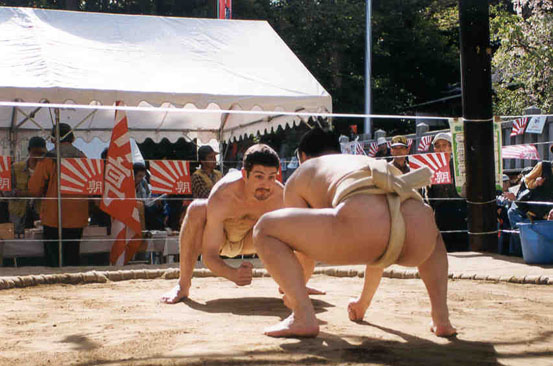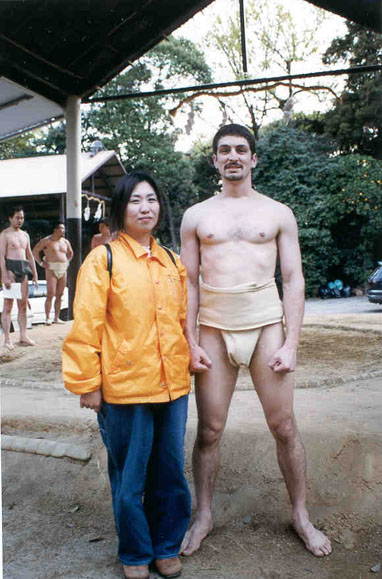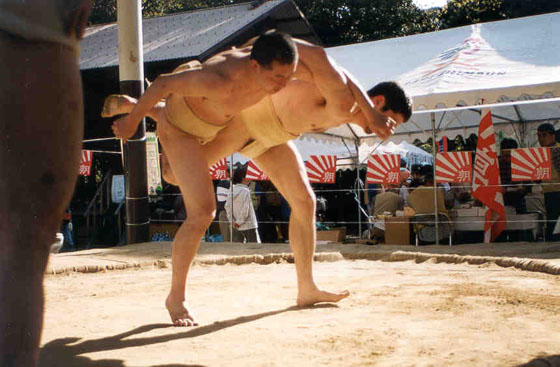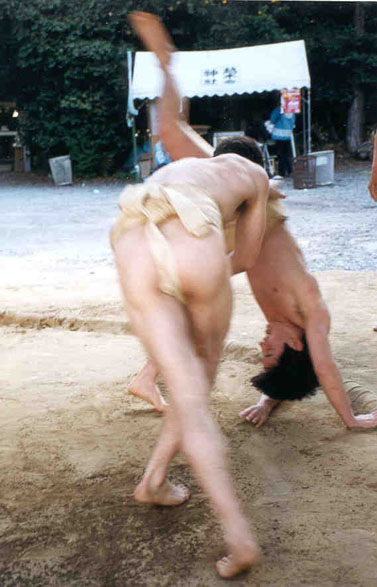 On your marks, get ready...
On your marks, get ready...
I have been lucky in Japan to have had various positive sumo experiences.
I guess they fall into three groups:
Watching live sumo competitions:
Meeting a real sumo wrestler:
Trying out sumo for myself:
Live sumo competitions are held six times a year for two weeks each.
They run all day, starting from the junior leagues and ending at 6 with
the top wrestlers of the top league. Sumo is televised in Japan every
afternoon of every tournament from 4 to 6. There are Japanese and
English broadcasts for various networks, and there is a summary of the
bouts every evening on shows like "sumo digest."
Live sumo can be seen in Tokyo (January, May, and September), Osaka (in March), Nagoya (July), and Fukuoka (November). The best tickets are impossible to get for any day unless you have connections, and if you do they are incredibly expensive. Standing room only seats are sold on the day of the event from 7:00 AM. This may sound torturous, but is not as bad as it sounds - at the beginning of the event you can see earliest bouts and have the best seats in the whole cavernous stadium to yourself and can move around easily and make friends, although you might have to give your seats up at 2 or 3 in the afternoon when the fat cats show up with the proper tickets.
I have been lucky enough to have been invited to two Osaka tournaments by a middle-aged student of mine whose husband receives tickets every year from a business associate. The seats are called masu-seki, named after a unit of rice. They are small squared-off areas with just enough room for four people to sit cross-legged or kneeling. Besides four people and their belongings, room has to be made for all of the goodies that are delivered to us - beer and sake, a boxed meal, presents from the sumo federation (one big bag of them per person, containing towels, bowels, dishes, food delicacies, etc.) as well as a bunch of snacks. Yum, but a real squeeze. The fuss of making room for everything and munching of the food, as well as the buzz of people walking by and the action happening in the neighboring seats is sometimes enough to distract the viewer from the bouts themselves. In March 1999 we went to the last day of competition, which is exciting because it is the day that the two strongest contenders get down and fight for the trophy and the championship that comes with it (a car, a years supply of rice and beer and shiitake mushrooms, a thousand salted plums, a million trophies, etc.), as well as the awards ceremony itself. Unfortunately, it had turned out to be one of the worst tournaments ever, considering that all three yokozuna were sitting out with injuries, but we were totally excited to be there. This year we went on the first day of the March 2000 tournament and saw four yokozuna compete, quite a rare chance. After the fifth day, one of the yokozuna who had already lost three bouts announced that he was dropping out of the tournament and would retire. It ended up being quite a tournament, with the lowest seeded wrestler getting on a winning streak of twelve straight victories. He lost the next two, but won on the last day to clinch the trophy. It was quite an emotional bout - when he realized that he had won it all he began to sob with joy. So did we. It's hard to believe that before the tournament began he had been considering retirement if he did poorly in March. In the following tournament, May 2000, he was promoted way up to komusubi, which is fourth from the top and just below yokuzuna, ozeki, and sekiwake.
I have also seen another type of event, this is the sumo road show.
Between tournaments there are six or seven weeks off, during this time
there are some sumo events which could best be described as sumo road shows.
They are one- or two-day events and they are held in cities that don't
house the official tournaments. Every summer there is an international
sumo road show, they have toured Canada, the U.S.A., England, Australia,
and other countries. These shows are not competitive tournaments,
more information gallery and fun events. For example, the art of
tying the chommage hairstyle is demonstrated, there is traditional
sumo singing, as well as sumo comedy, and bouts that have the wrestlers
more focused on demonstrating spectacular techniques than actually winning.
Lucky me, I have also met a real sumo wrestler. My wife's
husband has a work associate who sponsors part of a banquet for a certain
sumo stable called the Isutsu stable. This means that he had tickets
for about twenty people, and gave four tickets to my father-in-law.
Knowing that my wife and I have become big sumo fans recently, father-in-law
of course invited us. Isutsu stable is not one of the big stables,
but still has one wrestler in the top league and another in the league
just below that. The top wrestler is called Terao, and he is a kind
of hero of mine. Weighing only 115 kilos (253 pounds), he is the
lightest wrestler in the top league, he is also the oldest (36) and has
the longest career of any active wrestler - nearly 20 years, which is more
than half of his life. He is also muscular (i.e. not blubbery) and
quite handsome. The man has no faults, except that he doesn't always
win. Most of the time this is because he is outweighed by his opponents,
but this is one reason why I like him - he is always the underdog.
Weight isn't everything - last November in his home ground of Fukuoka he
beat the Hawaiian yokozuna, a man with twice his body weight. The
other big wrestler in the stable is Akinoshu, and there were several other
junior (but huge) wrestlers at the banquet, as well as the stable master
(Terao's brother, a former wrestler himself who once achieved a high rank)
as well as a gyoji, one of the little men in the wizard outfits
who referee matches from the danger zone within the ring itself.
The evening began with us getting seated. A big table full of food, lots of room to move around - in a way it was better than having ring-side seats since there was lots of room to move around. The wrestlers were announced, the doors opened and they filed in. There were speeches, then everybody began to eat and drink. The wrestlers began to circulate and sit at the tables to eat with the guests. They also circulated to take pictures with groups of people. A box was available for donations - people who had pictures taken with a sumo wrestler could make a donation. Terao came to my table and I had a chance to talk to him and shake his hand. I showed him a picture of me in a sumo competition of my own, I'm sure he thought I was just another pretentious foreigner trying to impress him, but maybe he was amused. He has been around forever, I'm sure he has seen it all. I also gave him a good luck charm that I had bought at a temple to wish him well. This particular temple is called Katsu-o-ji, and the three kanji Chinese characters of the temples, if read backwards, say Tera-o-katsu ("tera" can also be read "ji" in Japanese) which means "Terao victorious." He smiled and thanked me, saying that he had received a present like that before and knew about the temple. I was wondering if he knew about the temple, but he had been around for a long time and there were plenty of opportunities in the past for someone else to scoop me, no big deal. It was an honor for me to give it to him, I was the happiest guy in the room.
The entertainment continued for the rest of the evening, but it was
a bit anti-climactic. Maybe I had too much sake. When the evening
ended we collected out complimentary bag of presents and filed out past
the honorary members for bows, handshakes, and more photo opportunities.
It was a really great evening.
 Peter and Miki
Peter and Miki
When I was a high school student I was never much for team sports. I wasn't too good with the hand-eye coordination, so I had a problem throwing or kicking a ball in the direction that it was supposed to go. My balance was fine and I was quick and strong, and when I tried a bit of wrestling I found that I was well-suited to it. I wrestled for three years and got quite good, although never good enough to advance past the local school tournaments. My coach taught me one move that he called the "Chinese chinlock" which was inescapable and led to a pin every time, I got lazy and tried to set my opponents up in one every time. Wrestling was brutish, but it was primordial and ultimately quite satisfying and fun.
 On your marks, get ready...
On your marks, get ready...
Over the years I toyed with various other sports and martial arts, but nothing was quite as fun as wrestling. When I got to Japan, though, my luck changed. I stumbled across an announcement in the newspaper that a shrine just around the corner from my house was holding a "children's sumo" event, my curiosity got the better of me and I went to check it out. The children wrestled and had fun. They were all primary school children, mostly boys but also a few girls. I rooted for the girls every time, unfortunately they never won but I admired them for trying. After the kids, I was surprised to see an adult event - a local amateur sumo group threshed it out in the ring, tournament-style, eventually deciding a champion who received three big bottles of sake and a trophy. The final match was intense - a university student versus his coach from school. The university student was small and wiry, his coach was small and muscular, and both were lightning fast. Youth prevailed and the student took the sake home. I found out later that he doesn't even like sake and gave the bottles to his friends. After the competition was over the leader of the local group made an announcement that their group meets every Sunday at the shrine's sumo ring for practice and anyone is welcome. I decided to join. Foreigners who come to Japan learn karate and judo and kendo and maybe ninjutsu (ninja arts) but how many of them are drawn to sumo. Nobody in the group was much bigger than me, I vowed that the following year I would be the one going home with the three bottles of sake, and I sure wasn't going to be giving them away to my friends.
 Go!
Go!
A few weeks later I took them up on their offer and joined their sumo group. Not many people could speak English, so I had to make do with my poor Japanese (relying mostly on vocabulary and trying to avoid making sentences as much as possible) and got strapped into my mawashi. A mawashi is the thick cotton cloth that the wrestlers gird their loins with, and a fun new addition to the sport as far as I was concerned. The addition of the loincloth lends a lot to the sport, giving a wrestler something to get a good grip on that is not a sweaty arm or leg or wrist, and some leverage for wicked throws. It is what is used to physically lift the opponent out of the ring.
 Don't try this at home.
Don't try this at home.
I like the rules of sumo, since they make competition short but sweet. If somebody falls down or is pushed out of the ring they lose. I wish that competition was always that simple. When I was a kid and got in the occasional fight with some stupid kid, I could invariably get my opponent onto the ground and humiliate him that way, but I never had the heart to actually pummel him into submission. If kids could observe sumo rules, a lot of altercations could be resolved relatively painlessly.
The best thing about the group I wrestle with is that nobody is too big. This makes it less intimidating to start off. I found that I took to sumo quite well, as I could adapt the skills I already had from wrestling and I gained some confidence after I saw that I could beat more experienced opponents. It feels great to strip down and wear a loincloth, even on cool days it is invigorating. On really cold winter days when it gets down to five degrees Celsius (40 Fahrenheit or so) it is tough to wrestle, but you can keep warm by moving about or standing next to the small fire that is built in an oil drum. On those cold days the feet tend to suffer the most - the ground is colder than the air and you can't avoid contact with it no matter what you do - walking on your hands in the sumo ring is not encouraged.
I have been practicing with my group for a year and a half by now. I have traveled to a few outside tournaments, as well as taking part in the one we host. I have never been able to beat many opponents this way, perhaps being thrown off by wrestling an unfamiliar opponent. Amateur sumo tournaments like ours are always held at shrines and usually accompany a festival of some sort, so there is a fun atmosphere. One tournament was held at a famous ancient shrine in Nara, I went all that way on a cold day and got warmed up only to lose my first match. My opponent had been in training in a real sumo stable and dropped out, I guess he was a semi-pro. He crowded me out of the ring and I lost in seconds. I should have jumped over him and let him crowd himself out of the ring. Maybe next time. It was a bad draw. Many of the spectators at the events are amazed to see a foreigner in a loincloth taking part. I get a lot of friendly reactions, and one gentleman took some great pictures of me and sent me the copies as well as one that he had paid to have blown up. Thanks Mr. Nishihama.
For more information about the club I wrestle at, check this English
sumo
club news link.
Return to Home Page:
Return to Caveat Emptor Press contents page:
Return to Caveat Emptor Press overview page: